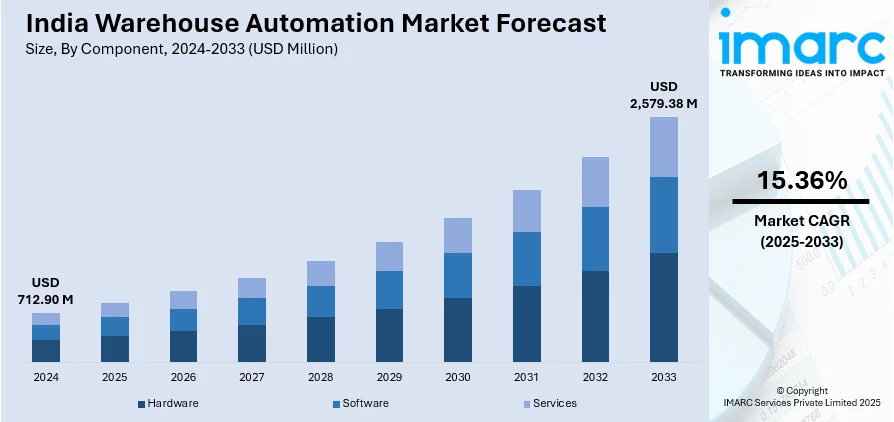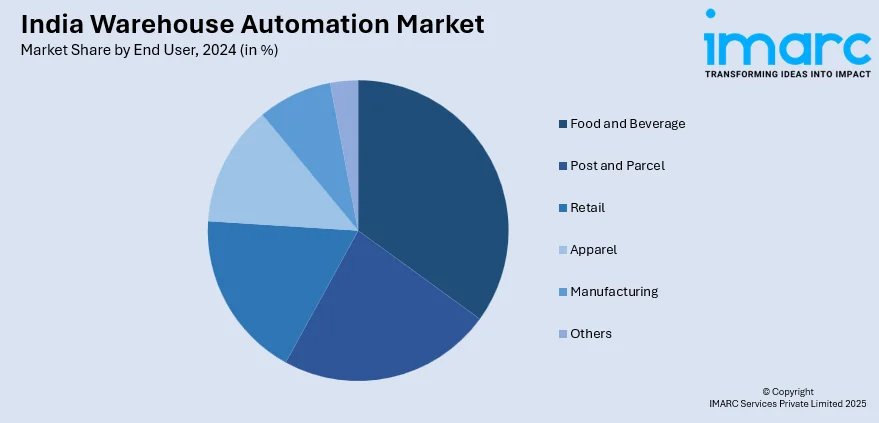
India Warehouse Automation Market Size, Share, Trends and Forecast by Component, End User, and Region, 2025-2033
India Warehouse Automation Market Overview:
The India warehouse automation market size reached USD 712.90 Million in 2024. Looking forward, IMARC Group expects the market to reach USD 2,579.38 Million by 2033, exhibiting a growth rate (CAGR) of 15.36% during 2025-2033. The key drivers include rapid e-commerce growth, rising labor costs, and demand for faster order fulfillment. Government initiatives including "Make in India" and increasing FDI in logistics further augment the India warehouse automation market share. Technological advancements in AI, robotics, and cloud-based WMS enhance efficiency, while the need for cost optimization and supply chain resilience accelerates automation investments.
|
Report Attribute
|
Key Statistics
|
|---|---|
|
Base Year
|
2024 |
|
Forecast Years
|
2025-2033
|
|
Historical Years
|
2019-2024
|
| Market Size in 2024 | USD 712.90 Million |
| Market Forecast in 2033 | USD 2,579.38 Million |
| Market Growth Rate 2025-2033 | 15.36% |
India Warehouse Automation Market Trends:
Rising Adoption of Robotics and AI in Warehouse Automation
The rise in the adoption of robotics and artificial intelligence (AI) to enhance operational efficiency is majorly driving the India warehouse automation market growth. With the rapid growth of e-commerce, logistics, and manufacturing sectors, businesses are increasingly deploying automated guided vehicles (AGVs), robotic arms, and autonomous mobile robots (AMRs) to streamline order fulfillment and inventory management. AI-powered systems are being used for predictive analytics, demand forecasting, and real-time tracking, reducing human errors and labor costs. According to a research report by the IMARC Group, the Indian supply chain analytics market reached a value of USD 385.4 Million in 2024. The market is estimated to reach USD 2,394.1 Million by 2033, demonstrating a compound annual growth rate (CAGR) of 20.6% from 2025 to 2033. In addition, advanced machine learning enables the creation of more intelligent warehouse management systems (WMS) to optimize storage utilization while minimizing downtime. This trend is being propelled forward by government programs such as "Make in India," accompanied by rising foreign investments. Robotics and AI are expected to dominate the warehousing automation space in India in the next 5 years, with businesses working towards faster delivery and cost-effective solutions.

To get more information of this market, Request Sample
Growth of Cloud-Based Warehouse Management Systems
Cloud-based WMS systems are trending in India due to their scalability, cost-effectiveness, and access to real-time data. Companies, especially in the e-commerce and retail sectors, are moving from on-premise WMS to cloud-based solutions to suit the demand for managing complex supply chains and multi-channel distributions. These systems easily integrate with Internet of Things (IoT) devices, RFID tracking, and automation technologies that help simplify inventory management and order accuracy. With SaaS models well adopted, advanced automation solutions are now available for even SMEs to adopt without large up-front costs. Furthermore, the rise of 5G technology is enhancing connectivity, ensuring faster data processing and smoother operations is also creating a positive India warehouse automation market outlook. According to Ericsson, India's 5G user base is expected to reach 970 million by 2030, which is equivalent to 74% of mobile subscribers. This expansion is driven by innovations in Generative AI and a growing appetite for high-quality services. By the end of the digital industry. This expansion has found a huge opportunity in the warehouse automation sector. As digital transformation accelerates across industries, cloud-based WMS is poised to become a key driver in India’s warehouse automation market, supporting agile and data-driven logistics operations.
India Warehouse Automation Market Segmentation:
IMARC Group provides an analysis of the key trends in each segment of the market, along with forecasts at the country level for 2025-2033. Our report has categorized the market based on component and end user.
Component Insights:
- Hardware
- Mobile Robots (AGV, AMR)
- Automated Storage and Retrieval Systems (AS/RS)
- Automated Conveyor and Sorting Systems
- De-palletizing/Palletizing Systems
- Automatic Identification and Data Collection (AIDC)
- Piece Picking Robots
- Software
- Warehouse Management Systems (WMS)
- Warehouse Execution Systems (WES)
- Services
- Value Added Services
- Maintenance
The report has provided a detailed breakup and analysis of the market based on the component. This includes hardware (mobile robots (AGV, AMR), automated storage and retrieval systems (AS/RS), automated conveyor and sorting systems, de-palletizing/palletizing systems, automatic identification and data collection (AIDC), and piece picking robots), software (warehouse management systems (WMS) and warehouse execution systems (WES)), and services (value added services and maintenance).
End User Insights:

- Food and Beverage
- Post and Parcel
- Retail
- Apparel
- Manufacturing
- Others
A detailed breakup and analysis of the market based on the end user have also been provided in the report. This includes food and beverage, post and parcel, retail, apparel, manufacturing, and others.
Regional Insights:
- North India
- South India
- East India
- West India
The report has also provided a comprehensive analysis of all the major regional markets, which include North India, South India, East India, and West India.
Competitive Landscape:
The market research report has also provided a comprehensive analysis of the competitive landscape. Competitive analysis such as market structure, key player positioning, top winning strategies, competitive dashboard, and company evaluation quadrant has been covered in the report. Also, detailed profiles of all major companies have been provided.
India Warehouse Automation Market News:
- February 13, 2025: Addverb unveiled three new AI-powered warehouse automation edge solutions: Trakr 2.0, a 20 kg load quadruped robot; Brisk, an intuitive interface for picking up products; and HOCA, or High-Order Carousel Automation for quick commerce. These small robots are designed to improve safety and efficiency in the Indian retail and warehouse industries. Addverb is working towards reducing dependency on foreign models and training costs as India moves to develop its own AI technologies, a step to strengthen the domestic warehouse automation scenario.
- August 01, 2024: Control One, a Bengaluru-based startup, launched India's first physical AI agent for warehouse automation. With real-time Vision-to-Action technology, forklifts and pallet movers can navigate autonomously using voice commands. It includes proprietary software that integrates with existing equipment, allowing one operator to monitor several machines simultaneously, increasing operational efficiency in today’s fast-moving environments. Application of Control One solution opens up a huge market where they can be utilized, especially with the support from investors including Tesla, iRobot, and GE, supported by big entities such as Nvidia.
India Warehouse Automation Market Report Coverage:
| Report Features | Details |
|---|---|
| Base Year of the Analysis | 2024 |
| Historical Period | 2019-2024 |
| Forecast Period | 2025-2033 |
| Units | Million USD |
| Scope of the Report |
Exploration of Historical Trends and Market Outlook, Industry Catalysts and Challenges, Segment-Wise Historical and Future Market Assessment:
|
| Components Covered |
|
| End Users Covered | Food and Beverage, Post and Parcel, Retail, Apparel, Manufacturing, Others |
| Regions Covered | North India, South India, East India, West India |
| Customization Scope | 10% Free Customization |
| Post-Sale Analyst Support | 10-12 Weeks |
| Delivery Format | PDF and Excel through Email (We can also provide the editable version of the report in PPT/Word format on special request) |
Key Questions Answered in This Report:
- How has the India warehouse automation market performed so far and how will it perform in the coming years?
- What is the breakup of the India warehouse automation market on the basis of component?
- What is the breakup of the India warehouse automation market on the basis of end user?
- What is the breakup of the India warehouse automation market on the basis of region?
- What are the various stages in the value chain of the India warehouse automation market?
- What are the key driving factors and challenges in the India warehouse automation market?
- What is the structure of the India warehouse automation market and who are the key players?
- What is the degree of competition in the India warehouse automation market?
Key Benefits for Stakeholders:
- IMARC’s industry report offers a comprehensive quantitative analysis of various market segments, historical and current market trends, market forecasts, and dynamics of the India warehouse automation market from 2019-2033.
- The research report provides the latest information on the market drivers, challenges, and opportunities in the India warehouse automation market.
- Porter's five forces analysis assist stakeholders in assessing the impact of new entrants, competitive rivalry, supplier power, buyer power, and the threat of substitution. It helps stakeholders to analyze the level of competition within the India warehouse automation industry and its attractiveness.
- Competitive landscape allows stakeholders to understand their competitive environment and provides an insight into the current positions of key players in the market.
Need more help?
- Speak to our experienced analysts for insights on the current market scenarios.
- Include additional segments and countries to customize the report as per your requirement.
- Gain an unparalleled competitive advantage in your domain by understanding how to utilize the report and positively impacting your operations and revenue.
- For further assistance, please connect with our analysts.
 Request Customization
Request Customization
 Speak to an Analyst
Speak to an Analyst
 Request Brochure
Request Brochure
 Inquire Before Buying
Inquire Before Buying




.webp)




.webp)












